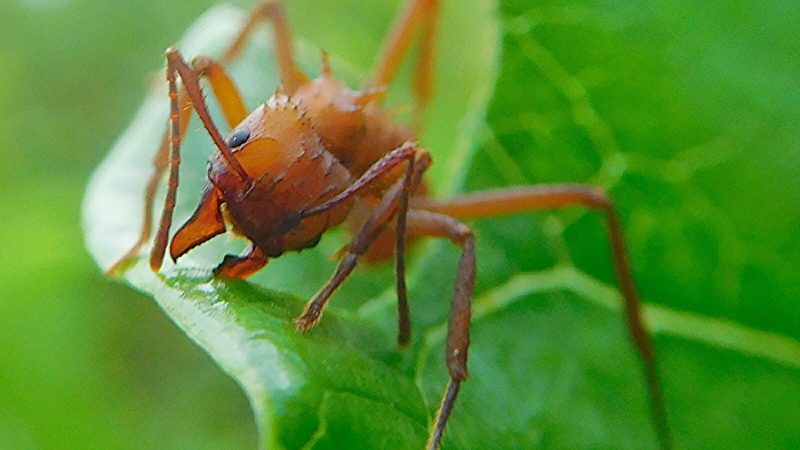What pulling power. Within seconds, dozens more Pharaoh ants had appeared at the impromptu funeral ‒ guardians of the cadaver. A rather quirky Robert Frost poem came to mind. In ‘Departmental’, Frost notes not only the humanoid-like efficiency of ants, but their preternatural strength, as one ant – ‘the solemn mortician’ ‒ heaves ‘high in air’ a dead moth ‘many times his size’, and ‘carries him out of there’. Frost was not wrong…
In various doomsday scenarios, such insects are predicted to take over a world rendered barren and inhospitable by man. It is not entirely preposterous. More than 90% of all current animal life forms are insects. Among these, ants are supreme. At least 12,000 identified species. Ubiquitous, they have colonised every land mass ‒ bar Antarctica. They have certainly colonised your garden. It is estimated that there are 1 million ants for every human on the planet. And they are aggressive, especially if you stray near their nests, pheromone-scented trails or hunting territory. Part of the larger order hymenoptera, their bee cousins are rarely malevolent unless threatened: ants, on the other hand, will attack at the drop of a hat, or a brush with a bush.
Ants have quite an armoury. Most formicidae, so called on account of their capacity to store a chemical called formic acid, possess powerful mandibles : they use them to attack, kill and devour small creatures, or to attach themselves to larger mammals including man. In the latter case, they clamp their jaws onto the exposed flesh, thus allowing the ant a degree of purchase. Once locked on, the insect can arch its back and either squirt formic acid into the punctured skin, or actually sting the victim. Formic acid, let it be known, is corrosive and capable of burning soft tissue. Fire ants have something even more unpleasant in their armoury ‒ highly toxic alkaloids which are contained in a venom sac. As for the South American bullet ant, its sting has been measured as the most painful of all insect stings.
Of course, what gives the humble ant most of its clout is the fact that it is a social insect with a highly organised sense of community. Safety in numbers. Strength in organisation.
Ants have complex nests: the weaver ants in my garden build football-sized structures in which the leaves are glued together by silk produced by the larvae. Even more inventive is the leafcutter ant, whose workers collect pieces of sawn off leaves. These are taken to the colony and fed to a specialised variety of fungus which grows in the nest and provides food. Here, as everywhere in ant communities, everyone has their appointed role and place in the hierarchy ‒ larvae, workers, guards, queens. It was weaver ant guards that attacked me years ago when I foolishly attempted to knock a nest to the ground. Ants literally rained down on me, biting me everywhere. The stench of formic acid assailed my nostrils. I tore off my clothes and plunged into the pool, but even when submerged, I was still being bitten. Water is no deterrent to a single-minded soldier ant.
Yet ants are not always the villains of the piece. In some contexts, they are victims rather than victors. Most insectivorous creatures will feast on a meal of termites or ants. Small birds such as magpie robins and mynahs quarter the concrete surrounds of my pool in the search for ants, as do the agamid lizards and skinks on active duty in the morning sunshine. Among mammals, anteaters and aardvarks feed almost exclusively on the wee beasties. A giant anteater can mop up to thirty thousand a day with the aid of its sticky, sixty centimetre long tongue. Thailand’s pangolin, incidentally the most trafficked animal in the world, feeds exclusively on termites and ants. Such a refined diet means that the scaly anteater is found only in one zoo – San Diego ‒ in the entire world.
In certain cultures, man, ever the apex predator, has joined the anteaters: he has long since found that ants can bolster a deficient diet with useful amounts of protein. In Southeast Asia, the eggs and larvae of the weaver ant sometimes appear on market stalls: they are considered a kind of poor man’s caviar, and their high price reflects the hazardous and potentially painful business of tackling their football-sized nests.
For centuries, the Chinese – who else ‒ have exploited this natural aggression. Aware of ants kamikaze-like capacity to defend their territory, Chinese farmers encourage these tree-dwelling species to nest in their citrus groves, thereby ensuring that their precious oranges and lemons are not attacked by thrips, caterpillars, mites or leaf miners, foliar feeding insects that might otherwise ruin an entire crop. A very effective bio-control.
As every gardener knows, and to his utter frustration, ants also act as protectors towards certain pests such as aphids. Aphids are bad enough on their own; they pierce the tender growing points of plants and suck out the sap. Moreover they breed at such a rate that an infestation can develop within days and can either seriously weaken the plant or even prove terminal. Nor is that the end of the story. Weakened and etiolated plants, coated with the sticky excrement of these green or white flies, then fall victim to other infestations such as sooty mould.
So where do ants come into the picture? They have a symbiotic relationship with these small flies, protecting them from insect predators such as lacewings or ladybirds, so that they can feast off this so-called ‘honey dew’, a sugary liquid which the aphids excrete. Green and white flies are among the gardener’s worst pests; the protective presence of ants merely exacerbates the problem.
Patrick Campbell’s book ‘The Tropic Gardener’, described in one Bangkok review as the best book on Thai gardening for 50 years, is available for B500 (half price) to personal callers from 59/84 Soi Saiyuan 13 in Rawai (Tel: 076-61227 or 085-7827551).








